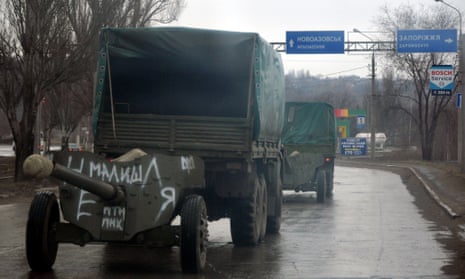Kiev’s forces have begun pulling back heavy weapons from the frontlines in eastern Ukraine, marking a step forward for the troubled peace plan agreed in Minsk this month.
Army command said on Thursday that it would withdraw 100mm cannons from the current demarcation line over the next 24 hours, barring attacks by Russia-backed rebels. Andriy Lysenko, a spokesman for the military, later said a second phase of the withdrawal would be pull back heavier weapons, including the 120mm mortars that have been a feature of the conflict.
The withdrawal of heavy weapons by both sides to create a buffer zone of up to 140km (87 miles) was the second point of the 12-point agreement brokered by the leaders of France, Germany, Ukraine and Russia in Minsk.
It was supposed to start two days after the fulfillment of the starting point, a ceasefire that took effect on 15 February. But the truce has been frequently violated, including the capture of the strategic city of Debaltseve by pro-Russia forces last week, delaying further progress. Kiev said this week that it would not pull back heavy weapons until pro-Russia forces stopped shelling.
Eduard Basurin, deputy militia commander of the self-declared Donetsk People’s Republic, said his forces had started withdrawing heavy weapons on Thursday morning from a demarcation line established in September. The Luhansk and Donetsk breakaway republics have previously announced they were pulling back heavy weapons, but these moves were not confirmed by the Organisation for Security and Cooperation in Europe, which is supposed to monitor the peace plan’s implementation.
The Guardian did not see any evidence of a withdrawal of heavy weapons on the Ukrainian front lines near Mariupol on Thursday, although locals said they had seen artillery being moved near a military checkpoint on the eastern edge of the city. Dmytro Chaly, military spokesman for the Mariupol area, later said units near the city had already begun pulling back 100mm MT-12 anti-tank cannons to positions not less than 25km from the front line.
Andrei Purgin, speaker of the people’s council of the self-declared Donetsk People’s Republic, told Russian news agency Interfax on Thursday that “it seems like [Ukrainian forces] have started to move back some equipment”.
Associated Press reporters on Thursday also saw rebel forces moving at least six 120mm self-propelled howitzers from the front line near Olenivka, a town south of the rebel-held stronghold of Donetsk.
Shelling attacks have dropped off in eastern Ukraine in recent days, paving the way for the withdrawal of heavy weapons. Kiev said on Thursday that although isolated shootouts had occurred, its positions had not been shelled over the previous night.
The Ukrainian military said it had not suffered any casualties for the second straight day on Thursday. Wednesday was the first time in “at least several weeks” that no soldiers had been killed, according to a spokesman.
Ukrainian and Western leaders fear that pro-Russian side is building up its forces to capture Mariupol, an important steelmaking and port city on the Azov Sea. On Tuesday, the Guardian heard intense mortar and heavy machine gun fire near Shyrokyne, a town outside Mariupol that has become a flashpoint after Kiev’s forces took control of it in the days before the ceasefire.
Chaly said the withdrawal of cannons would “not affect the defence of Mariupol” since Kiev’s forces had enough troops, fighting vehicles and other weapons to protect its positions.
Jens Stoltenberg, Nato’s secretary general, said Russia had delivered more than 1,000 pieces of equipment to rebels in recent months, including heavy weapons such as tanks and artillery. The Kremlin has denied arming the pro-Russia forces in Ukraine.
Also on Thursday, rebels took prisoners of war to the Donetsk airport, which was heavily damaged in months of fighting with Ukrainian troops nicknamed as “cyborgs” for their resilience, to dig the bodies of their fallen comrades out from the rubble. Five bodies had been recovered on Wednesday.
A popular rebel commander who goes by the nom de guerre Motorola said prisoner labour was being used because “it’s not our job to recover dead bodies, it’s our job to make them”.
“They take their comrades out to return them to their mums and dads. Did they think we would feed them for free?” Motorola told reporters.
